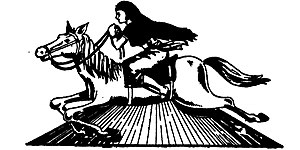Khunu Leima
| Khunu Leima | |
|---|---|
| Member of Lairembis | |
 Goddess Khunu Leima | |
| Other names |
|
| Affiliation | Meitei mythology (Manipuri mythology) and Meitei religion (Sanamahism) |
| Animals | pigeons and doves |
| Symbols | pigeons and doves |
| Gender | Female |
| Region | Manipur, Northeast India |
| Ethnic group | Meitei ethnicity |
| Festivals | Lai Haraoba |
| Personal information | |
| Parents | Salailen (Soraren) |
| Siblings | Nganu Leima and Shabi Leima |
Khunu Leima (/khoo-noo lei-ma) or Khunureima (/khoo-noo-rei-ma) is the goddess of pigeons and doves in Meitei mythology and religion. She is a sister of goddesses, Nganu Leima and Shabi Leima. Legend says that all the three sisters married to a single mortal man.[1][2][3][4][5]
Etymology[edit]
The Meitei female given name "Khunu Leima" (ꯈꯨꯅꯨ ꯂꯩꯃ) is made up of two component words. The two words are "Khunu" (ꯈꯨꯅꯨ) and "Leima" (ꯂꯩꯃ). In Meitei, "Khunu" (ꯈꯨꯅꯨ) means pigeon.[6] The word "Leima" (ꯂꯩꯃ) is further made up of two component words, "Lei" (ꯂꯩ) and "Ma" (ꯃ). "Lei" (ꯂꯩ) means land or earth. "Ma" (ꯃ) means "mother". Literally, "Leima" (ꯂꯩꯃ) can be translated as "Land Mother" or "Mother Earth". But in general context, "Leima" (ꯂꯩꯃ) means a queen or a mistress or a lady.[7]
Description[edit]
Goddess Khunu Leima is described as the mistress of all the pigeons of the world. At any moment, she could summon all the pigeons at any place she wishes. She is one of the daughters of God Salailen (alias Soraren).[2][8]
Related pages[edit]
- Imoinu (Emoinu) - Meitei goddess of wealth
- Ireima (Ereima) - Meitei goddess of water
- Leimarel (Leimalel) - Meitei goddess of earth
- Ngaleima - Meitei goddess of fish
- Panthoibi - Meitei goddess of civilization, love and warfare
- Phouoibi (Phouleima) - Meitei goddess of agricultural crops
- Thumleima - Meitei goddess of salt
References[edit]
- ↑ Singh, Moirangthem Kirti (1993). Folk Culture of Manipur. Manas Publications. ISBN 978-81-7049-063-0.
- ↑ 2.0 2.1 Manipuri Phungawari. 2014. p. 202.
{{cite book}}:|website=ignored (help) - ↑ Eben Mayogee Leipareng. 1995. p. 107.
{{cite book}}:|website=ignored (help) - ↑ Tal Taret. 2006. p. 43.
{{cite book}}:|website=ignored (help) - ↑ Regunathan, Sudhamahi (2005). Folk Tales of the North-East. Children's Book Trust. ISBN 978-81-7011-967-8.
- ↑ "Learners' Manipuri-English dictionary.Khunu". uchicago.edu. 2006.
- ↑ "Learners' Manipuri-English dictionary.Leima". uchicago.edu. 2006.
- ↑ Tal Taret. 2006. p. 46.
{{cite book}}:|website=ignored (help)
Bibliography[edit]
- Glimpses of Manipuri Culture - Dr. Yumlembam Gopi Devi
- The History of Manipur: An early period - Wahengbam Ibohal Singh · 1986
